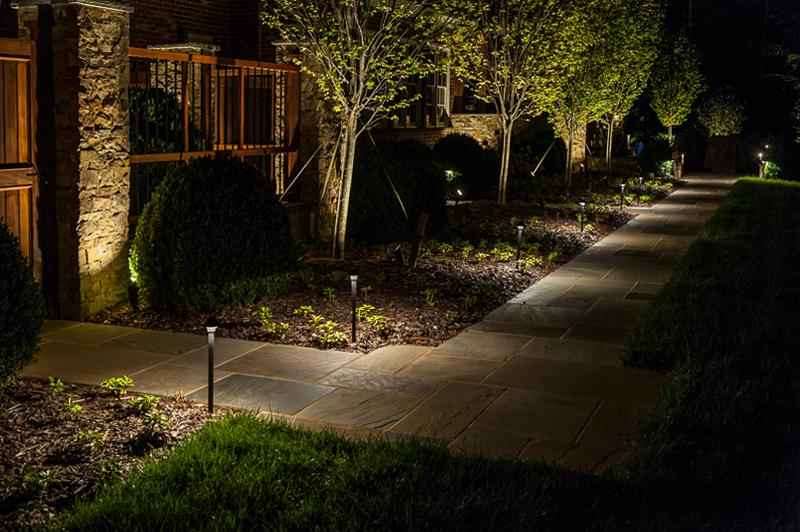
By jrandall
Sep 18, 2023
Outdoor lighting isn’t just about aesthetics; it’s a carefully crafted science that combines design principles, practical considerations, and safety measures to enhance the overall experience. This blog will explore the fascinating world of effective pathway lighting, unraveling the science behind it and explaining how it impacts safety and aesthetics.
Pathway lighting serves a crucial role in our urban environments. It isn’t just about making your way from point A to point B; it’s about doing so safely and beautifully. Effective pathway lighting offers numerous benefits:
One of the primary reasons for pathway lighting is safety. Well-lit pathways reduce the risk of accidents, making them a must for homes. Illuminating walkways ensure people can see where they’re going, avoid obstacles, and prevent trips and falls. This is particularly important in areas with high foot traffic or uneven terrain.
Pathway lighting isn’t limited to functionality; it’s also a powerful tool for enhancing the aesthetics of outdoor spaces. Properly designed lighting can transform an ordinary walkway into a visually stunning feature, adding to the charm and character of the surrounding environment. Whether it’s a garden, a poolside, or a patio, lighting can set the mood and create a unique atmosphere.
Effective pathway lighting goes beyond randomly placing fixtures along a walkway. It’s a carefully planned process that relies on several scientific principles:
The key to effective pathway lighting lies in determining the appropriate lighting levels. This involves calculating the number of lumens you need to adequately illuminate the pathway while minimizing glare and light pollution. Factors like the pathway’s width, the surrounding environment, and the desired ambiance play a role in these calculations.
Color temperature is another critical factor. The choice of warm or cool lighting can significantly impact the mood and visibility of the pathway. Warm light (around 2700-3000K) tends to create a cozy, inviting atmosphere, while cool light (4000K and above) can make spaces feel more modern and energetic. The selection depends on the intended use of the pathway.
The science of pathway lighting also involves strategic fixture placement. Fixtures should minimize shadows and ensure even illumination. This requires an understanding of photometric and light distribution principles, ensuring that no areas are overly bright or too dim.
While the science behind pathway lighting is fascinating, practical considerations play an equally important role in its effectiveness:
In today’s environmentally conscious world, energy efficiency is paramount. LED lighting has become the go-to choice for pathway lighting due to its low energy consumption and long lifespan. Smart lighting systems can also adjust brightness based on real-time needs, further conserving energy.
You should maintain pathway lighting regularly to ensure its effectiveness. Burnt-out bulbs or damaged fixtures can create safety hazards and detract from the overall experience. Routine inspections and maintenance schedules are crucial to keeping pathways well-lit and safe.
Pathway lighting and safety go hand in hand. Here’s how effective lighting impacts safety:
Well-lit pathways are less inviting to potential criminals, reducing the risk of theft, vandalism, or other criminal activities. Adequate lighting can deter wrongdoers and make users feel safer, especially in secluded areas.
As mentioned earlier, proper lighting minimizes accidents by helping pedestrians navigate their way safely. This is especially vital in areas where people may walk after dark, such as college campuses, parks, or parking lots.
Pathway lighting isn’t just about function; it can also be a work of art. Here’s how it enhances aesthetics:
Pathway lighting can accentuate the beauty of the surrounding landscape. By illuminating trees, sculptures, or architectural features, lighting designers create a visually pleasing environment that adds depth and character to the space.
The color temperature and design of the lighting fixtures can set the mood for the pathway. Soft, warm lighting can create a romantic atmosphere, while bolder, cooler lighting can convey a sense of modernity and energy.
Lights Over DMV is your trusted partner in crafting mesmerizing, safe, and efficient outdoor lighting solutions in Bowie, MD. Whether you’re a homeowner looking to transform your garden or backyard, we’ve got you covered.
Join us at Lights Over DMV, where science meets artistry to create enchanting pathways. Take the first step towards brilliance today – contact us for a free consultation, and let’s light up your world with our landscape lighting services.
Fill out the form, or call us to
set up a free in-home consultation.
This will close in 0 seconds
No comment yet, add your voice below!